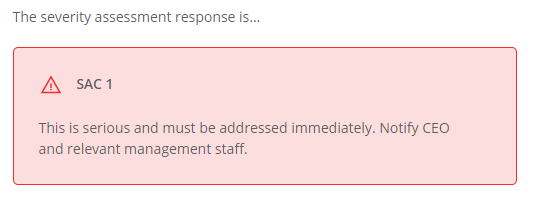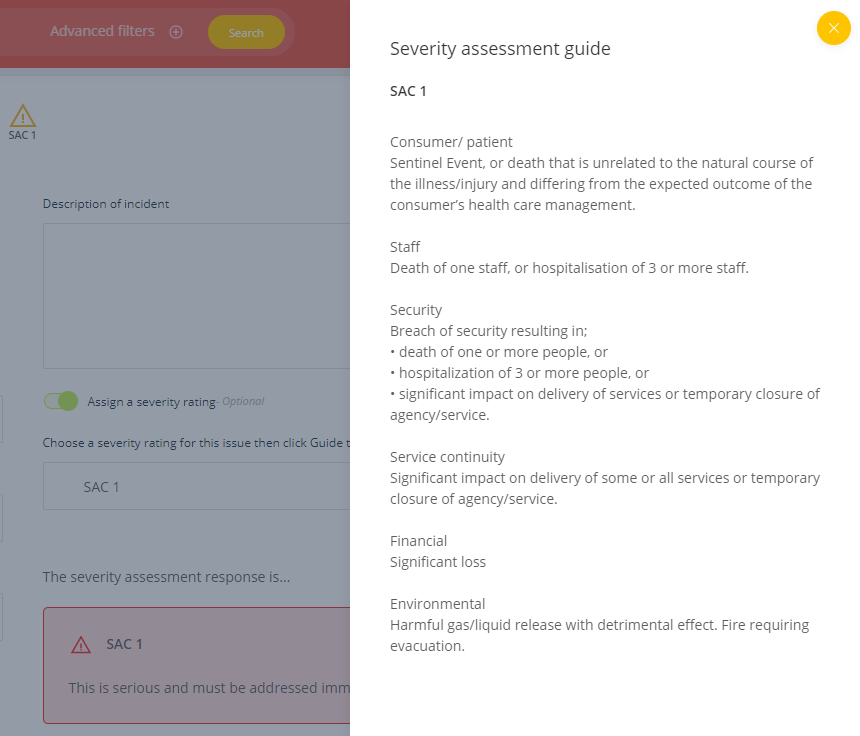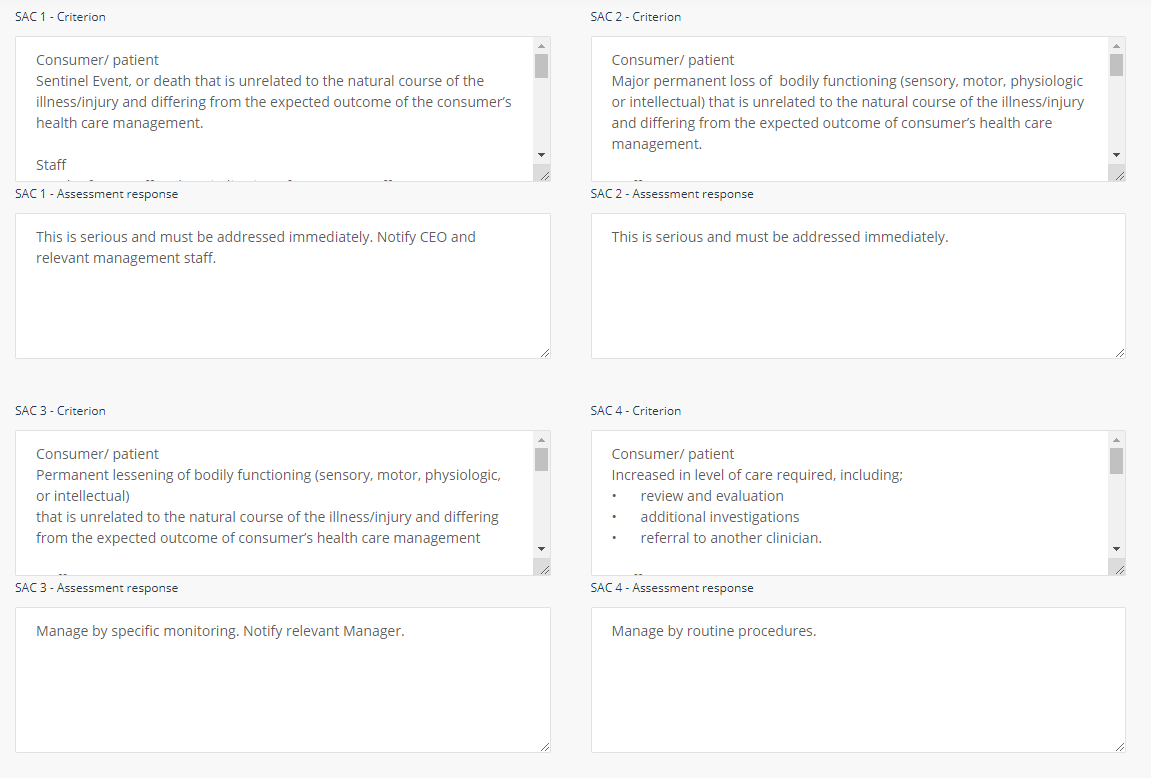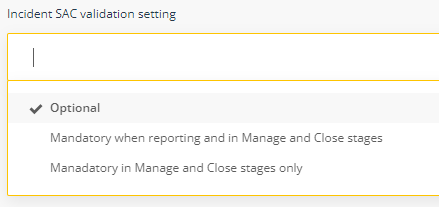Severity Access Code (SAC) settings
The LogiqcQMS platform enables you to apply a severity rating on reported events, e.g., complaints, incidents, hazards, non-conformances, and repairs. This article shows you how to edit your Severity settings.
Editing your SAC settings requires admin permissions. Learn more
This article covers the following:
About the severity settings (SAC or ISR)
Setting your severity settings
Controlling SAC validation for Incidents
Severity (SAC) settings by jurisdiction - example content
About the severity settings (SAC or ISR)
The Reporting registers (Incidents, Feedback, Improvement and Repairs) allow the user to assign a severity rating to the issue being reported.
A severity rating is most commonly user to classify incidents. Incident severity levels are a measurement of impact. When an incident is reported in the platform, the user has an option to assign a severity rating:

Severity rating language – You can set the language for each of the severity levels displayed in the system in Admin mode/Severity settings eg. ‘SAC 4’ could be replaced with ‘ISR 4’.

Severity assessment response
When a severity rating is selected, a brief policy statement about how the nature of the response required is displayed:

You can set the text that appears in the severity assessment response panel in Admin mode/Severity settings
Severity assessment guide
When a severity rating is selected, the user can click on a 'help' icon to display guidance relating to the severity level selected. You can set the guidance text that appears in Admin mode/Severity settings. A hyperlink to a document on the Document register can also be set to appear on this page. 

Setting your severity settings
- Switch to Admin mode via your user account menu.
- Select Severity settings under the Administration menu
- Type your preferred language into the Severity value field with level one being the highest severity value and level four being the lowest

- For each severity Criterion and Assessment response enter the corresponding preferred text to appear in the platform when the user selects that value

- (Optional) Select a relevant document from your Document Register to display as a hyperlink on the Severity assessment guide panel. This is typically a link to your organisation’s incident management policy

- Click 'Save' at the bottom of the form

Controlling SAC validation for Incidents.
You can control whether selection of a severity level is mandatory or not in Admin mode/System settings:

About the options.
-
Optional - allows the user the option to select a SAC rating. (not a mandatory field)
-
Mandatory when reporting and in Manage and Close stages - A SAC rating must be selected when reporting an incident. Can be edited during the manage and close stage.
-
Mandatory in Manage and Close stages only - Reporters can report an incident without choosing a SAC rating. However, a SAC rating must be selected in at least one of the workflow stages (Manage, Approve) before the Incident can be approved and closed
Severity (SAC ) settings by jurisdiction - example content
Below are Severity setting examples based on current published guidelines for each jurisdiction in Australia and those relevant to New Zealand. The example taxonomy includes values for the following:
- Severity Value
- Criterion/definition
- Assessment response
New South Wales
|
Severity Value |
Criterion (Guide) |
Assessment response |
|
Harm Score 1 |
Clinical Harm - Unexpected death or Australian Sentinel Event as defined in the Australian Sentinel Event List v2 Corporate Harm - Unexpected death of a worker or visitor or a complete loss of service |
This is serious and must be addressed immediately. Notify senior management who will notify the CEO.
|
|
Harm Score 2 |
Clinical Harm - Major Harm |
This is serious and must be addressed immediately. Notify senior management who will notify the CEO. |
|
Harm Score 3 |
Clinical Harm - Minor Harm |
Manage by specific monitoring. Notify relevant senior management. |
|
Harm Score 4 |
Clinical Harm - No harm or near miss |
Manage by routine procedures. |
Source: Incident management NSW Health
Queensland
|
Severity Value |
Criterion |
Assessment response |
|
SAC 1 |
Death or likely permanent harm which is not reasonably expected1 as an outcome of health care. 1. ‘Not reasonably expected’ by the treating clinicians, patient, family, or carer |
This is serious and must be addressed immediately. Notify senior management who will notify the CEO. |
|
SAC 2 |
Temporary harm which is not reasonably expected as an outcome of healthcare. - Additional investigation performed - Surgical intervention - Procedure involving wrong patient or body part resulting in temporary harm. |
This is serious and must be addressed immediately. Notify senior management who will notify the CEO. |
|
SAC 3 |
Minimal or no harm which is reasonably expected as an outcome of health care: - First aid treatment only required |
Manage by specific monitoring. Notify relevant senior management. |
|
SAC 4 |
No harm or near miss |
Manage by routine procedure |
Source: Queensland Health
South Australia
|
Severity Value |
Criterion |
Assessment response |
|
Incident Severity Rating ISR 1 |
Death or Sentinel event – no further treatment |
This is serious and must be addressed immediately. Notify senior management who will notify the CEO |
|
ISR 2 |
Incident resulting in major harm - Permanent loss or function - Requirement for immediate emergency or palliative treatment for life-threatening condition - Long term high level care expected - Unplanned surgical intervention resulting in a higher level care/therapy |
This is serious and must be addressed immediately. Notify senior management who will notify the CEO. |
|
ISR 3 |
Incident resulting in minor harm. - Additional clinical review, first aid, treatment, or therapies - Increased monitoring is required |
Manage by specific monitoring. Notify relevant senior management. |
|
ISR 4 |
Incident resulting in no harm or near miss |
Manage by routine procedure |
Source: South Australia Health
Victoria
|
Severity Value |
Criterion |
Assessment response |
|
Incident Severity Rating (ISR1) |
Severe/ Death |
This is serious and must be addressed immediately. Notify senior management who will notify the CEO. |
|
ISR 2 |
Moderate |
This is serious and must be addressed immediately. Notify senior management who will notify the CEO. |
|
ISR 3 |
Mild |
Manage by specific monitoring. Notify relevant senior management. |
|
ISR 4 |
No harm/Near miss |
Manage by routine procedure |
Policy - Adverse Patient Safety Events.pdf (safercare.vic.gov.au)
Western Australia
|
Severity Value |
Criterion |
Assessment response |
|
SAC 1 |
Physical/psychological serious harm or death; that has, or could have (near miss), be attributed to health care provision (or lack thereof) rather than the patient’s underlying condition or illness. - Sentinel event - Clinical incident resulting in serious harm or death - Escalation of care in impatient setting - Increased length of stay greater than 7 days - Near miss that could have resulted in serious harm or death. |
This is serious and must be addressed immediately. Notify senior management who will notify the CEO.
|
|
SAC 2 |
Physical/psychological moderate harm that has, or could have (near miss), be attributed to health care provision (or lack thereof) rather than the patient’s underlying condition or illness. - Increased length of stay more than 72 hours less than 7 days - Additional investigations performed - Referral to another clinician - Surgical intervention - Medical interventions - Increased frequency of mental health clinical review - Near miss that could have resulted in moderate harm |
This is serious and must be addressed immediately. Notify senior management who will notify the CEO.
|
|
SAC 3 |
Physical/psychological minor or no harm that has or could have (near miss) be attributed to health care provision (or lack thereof) rather than the patient’s underlying condition or illness - No harm - Only first aid treatment required - Minor harm resulting in increased length of stay up to 72 hours - Increased frequency of mental health clinician review - Near miss that could have resulted in minor harm.
|
Manage by specific monitoring. Notify relevant senior management. |
Source: West Australia Department of Health
New Zealand
|
Severity Value |
Criterion |
Assessment response |
|
SAC 1 / Severe |
Death or permanent severe loss of function: - Not related to the natural course of the illness - Differs from the immediate expected outcome of the care management - Can be sensory, motor, physiological, psychological, or intellectual |
This is serious and must be addressed immediately. Notify senior management who will notify the CEO.
|
|
SAC 2 /Major |
Permanent major or temporary severe loss of function - Not related to the natural course of the illness - Differs from the immediate expected outcome of the care management - Can be sensory, motor, physiological, psychological, or intellectual |
This is serious and must be addressed immediately. Notify senior management who will notify the CEO.
|
|
SAC 3 / Moderate to Minor |
Temporary major loss of function - Not related to the natural course of the illness - Differs from the immediate expected outcome of the care management - Can be sensory, motor, physiological, psychological, or intellectual Requiring increased level of care including - Review and evaluation - Additional investigations - Referral to another clinician |
Manage by specific monitoring. Notify relevant senior management. |
|
SAC 4 / Minimal |
Near miss No injury No increased level of care or length of stay |
Manage by routine procedure |
Severity Assessment Code (SAC) rating and triage tool for adverse event reporting